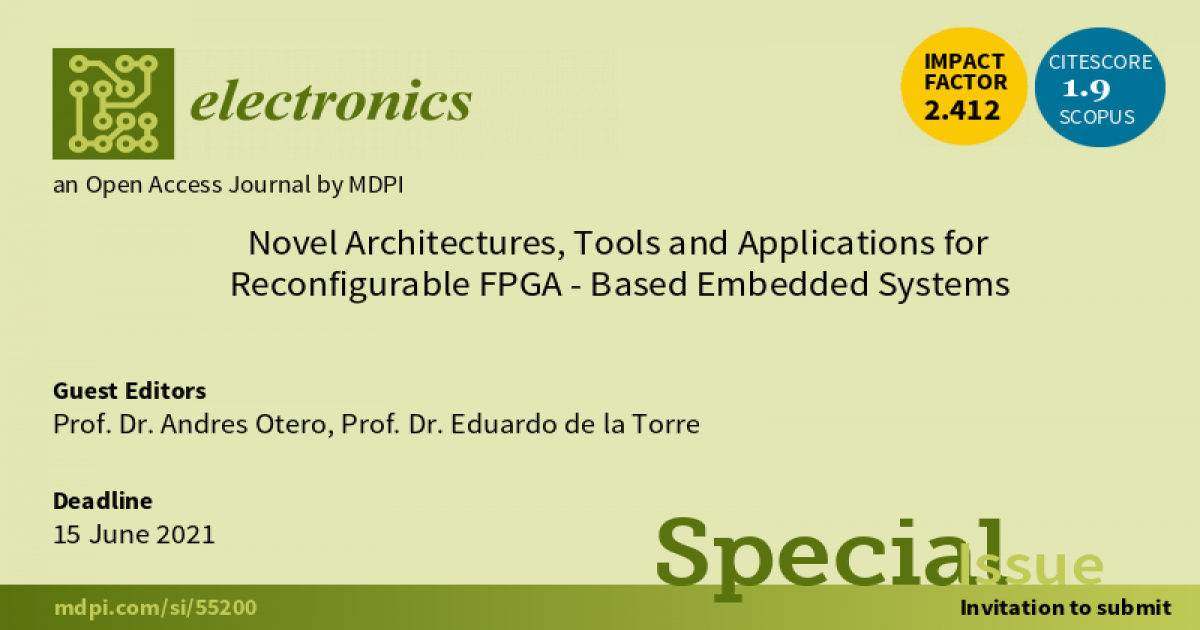- 2.6Impact Factor
- 6.1CiteScore
- 17 daysTime to First Decision
Novel Architectures, Tools and Applications for Reconfigurable FPGA-Based Embedded Systems
This special issue belongs to the section “Computer Science & Engineering“.
Special Issue Information
Dear Colleagues,
Reconfigurable computing is nowadays a reality that is already being exploited in both research and industrial scenarios, which benefit from the combination of flexibility and high performance provided by this technology. Such a combination makes reconfigurability an enabling technology for self-adaptation in multiple domains, as well as the technology substrate on which evolvable and approximate circuits may operate. Design flows for reconfigurable computing, which were previously only available in academic works, are now being integrated as part of commercial tools. However, multiple research opportunities can still be identified.
In this Special Issue, we look forward to receiving original contributions providing novel architectures to exploit all of the possibilities offered by embedded reconfigurable devices. These novel architectures require custom design flows and supporting tools to extend the options already incorporated into commercial solutions. Application papers showing implementations and deployments in different scenarios are very welcome as well, with a particular accent on reconfigurable systems working under safety-critical requirements, such as aerospace or automotive.
Prof. Dr. Andres Otero
Prof. Dr. Eduardo de la Torre
Guest Editors
Manuscript Submission Information
Manuscripts should be submitted online at www.mdpi.com by registering and logging in to this website. Once you are registered, click here to go to the submission form. Manuscripts can be submitted until the deadline. All submissions that pass pre-check are peer-reviewed. Accepted papers will be published continuously in the journal (as soon as accepted) and will be listed together on the special issue website. Research articles, review articles as well as short communications are invited. For planned papers, a title and short abstract (about 250 words) can be sent to the Editorial Office for assessment.
Submitted manuscripts should not have been published previously, nor be under consideration for publication elsewhere (except conference proceedings papers). All manuscripts are thoroughly refereed through a single-blind peer-review process. A guide for authors and other relevant information for submission of manuscripts is available on the Instructions for Authors page. Electronics is an international peer-reviewed open access semimonthly journal published by MDPI.
Please visit the Instructions for Authors page before submitting a manuscript. The Article Processing Charge (APC) for publication in this open access journal is 2400 CHF (Swiss Francs). Submitted papers should be well formatted and use good English. Authors may use MDPI's English editing service prior to publication or during author revisions.
Keywords
- FPGA
- reconfigurable computing
- self-adaptation
- design tools
- architectures
- evolvable hardware
- approximate computing

Benefits of Publishing in a Special Issue
- Ease of navigation: Grouping papers by topic helps scholars navigate broad scope journals more efficiently.
- Greater discoverability: Special Issues support the reach and impact of scientific research. Articles in Special Issues are more discoverable and cited more frequently.
- Expansion of research network: Special Issues facilitate connections among authors, fostering scientific collaborations.
- External promotion: Articles in Special Issues are often promoted through the journal's social media, increasing their visibility.
- e-Book format: Special Issues with more than 10 articles can be published as dedicated e-books, ensuring wide and rapid dissemination.

